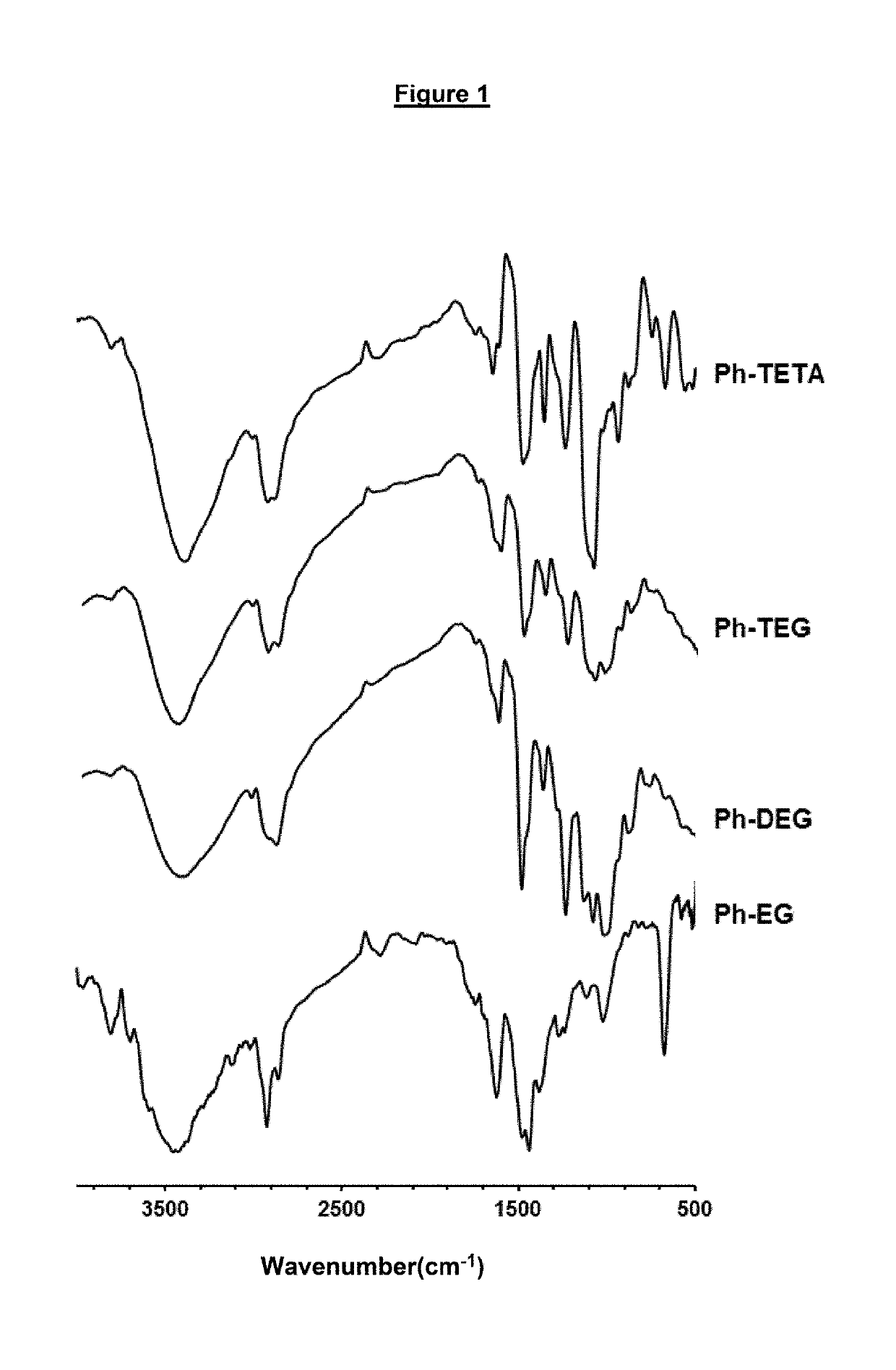Cross-linked polymeric resin and methods of use
- Summary
- Abstract
- Description
- Claims
- Application Information
AI Technical Summary
Benefits of technology
Problems solved by technology
Method used
Image
Examples
example 1
[0113]Materials and Methods: Phenol (Ph), ethylene glycol (EG), diethylene glycol (DEG), triethylene glycol (TEG) and Tetraethylene glycol (TETA) and paraformaldehyde were purchased from Fluka Chemie AG (Buchs, Switzerland). heptane was supplied by Sigma-Aldrich, Germany. All other solvents and reagents employed were of analytical grade. The infrared spectra were recorded were analysed by Perkin Elmer 16F PC FTIR spectrometer in the 4000-500 cm-1 wavelength region. The solid NMR spectra were recorded by Bruker WB-400 spectrometer with a spinning rate of 10 KHz. The cross-linked polymers were analysed for powder xray diffraction by Rigaku Miniflex II Desktop X-ray Diffractometer with 30 and stop angle of 700 sampling step size of 0.03, scan speed 3.00, 30 KV and 15 mA. The concentrations of mercury samples before and after analysis were analysed Inductively Coupled Plasma Mass Spectroscopy model ICP-MS XSeries-II (Thermo Scientific). Thermal properties of the synthesized cross-linked...
example 2
[0114]Synthesis and characterization: In a typical experiment: phenol (0.05 mol), glycol (0.15 mol), paraformaldehyde (0.3 mol) and concentrated hydrochloric acid (0.02 mol) were mixed in 25 ml of heptane in a 50 round bottom flask. The reaction mixture was heated and stirred at 80° C. for 24 hours. The light yellow solid produced was crushed and washed in distilled water and methanol, and dried at 60° C. under vacuum until constant weight was achieved (See Table 1, Scheme 1).
TABLE 1Reaction yield and elemental analysis of the synthesizedphenol-glycol based cross-linked polymers.Elemental analysis (%)Polymer*Yield (%)CHPh-EG39.1138.916.76Ph-DEG3238.497.08Ph-TEG33.641.146.41Ph-TETA26.541.757.15*Reaction yield was calculated by = mass of product / mass of reactants × 100%, (reactants = phenol, formaldehyde, glycol and hydrochloric acid)).
example 3
[0115]Adsorption studies: The adsorption experiments were performed as batch experiments, where experiments were conducted as follow: a 20 ml solution of mercury at a certain concentration, certain pH and certain temperature was added 30 mg of cross-linked polymer and stirred for a certain time [Al Hamouz O C S, Estatie M, Saleh T A. “Removal of cadmium ions from wastewater by dithiocarbamate functionalized pyrrole based terpolymers.” Sep Purif Technol. 2017; 177:101-109]. The concentrations of mercury (II) ions before and after the adsorption were analyzed by ICP. And the adsorption capacity was calculated:
qe=(Co-Ce)×VW(1)
Where qe represents the adsorption capacity (mg / g), Co and Ce represents the initial concentration of mercury ions and the concentration of mercury ions left in the solution after adsorption, respectively (mg / L). V represents the volume of the solution (L) and W represents the mass of the polymers inserted in the solution (g).
PUM
| Property | Measurement | Unit |
|---|---|---|
| Temperature | aaaaa | aaaaa |
| Temperature | aaaaa | aaaaa |
| Fraction | aaaaa | aaaaa |
Abstract
Description
Claims
Application Information
 Login to view more
Login to view more - R&D Engineer
- R&D Manager
- IP Professional
- Industry Leading Data Capabilities
- Powerful AI technology
- Patent DNA Extraction
Browse by: Latest US Patents, China's latest patents, Technical Efficacy Thesaurus, Application Domain, Technology Topic.
© 2024 PatSnap. All rights reserved.Legal|Privacy policy|Modern Slavery Act Transparency Statement|Sitemap



